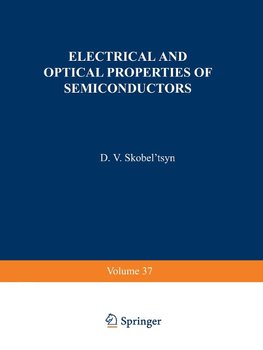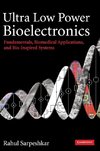
-
 Anglický jazyk
Anglický jazyk
Electrical and Optical Properties of Semiconductors
Autor: D. V. Skobel Tsyn
Radiative Recombination at Dislocations in Germanium.- 1. Potentialities of Radiative Recombination as a Method of Investigation.- 2. Energy Structure of Dislocations in Germanium Crystals.- I. Experimental Method.- 1. Preparation of Crystals with High Dislocation... Viac o knihe
Na objednávku
49.49 €
bežná cena: 54.99 €
O knihe
Radiative Recombination at Dislocations in Germanium.- 1. Potentialities of Radiative Recombination as a Method of Investigation.- 2. Energy Structure of Dislocations in Germanium Crystals.- I. Experimental Method.- 1. Preparation of Crystals with High Dislocation Densities.- 2. Preparation of Samples.- 3. Apparatus for Measuring Recombination Radiation Spectra.- II. Radiative Recombination in Germanium Crystals with Dislocation Densities of 103104 cm-2.- 1. Dependence of the Dislocation Band Profile on the Degree of Doping.- 2. Dependence of the Dislocation Band Profile on the Nonequilibrium Carrier Density.- 3. Dependence of the Dislocation Band Intensity on the Injection Current.- III. Radiative Recombination in Germanium Crystals with High (105-106 cm-2) Dislocation Densities. Radiative Recombination Mechanism.- 1. Dependence of the Form of the Spectrum on the Position of the Fermi Level and on the Injection Current.- 2. Analysis of the Radiation Band Profile.- 3. Temperature Dependence of the Radiation Band Width. Mechanism of Radiative Recombination at Dislocations.- 4. Interpretation of Experimental Results by Means of Intra-Center Transitions.- IV. Determination of the Quantum Yield of the Recombination Radiation Associated with Dislocations.- Conclusions.- Literature Cited.- Impact Ionization of Impurities in Germanium at Low Temperatures.- I. Impact Ionization (Review).- 1. Impact Ionization in Rarefied Gases and in Semiconducting p-n Junctions.- 2. Impact Ionization in Homogeneous Semiconductors.- 3. Impact Ionization of Neutral Impurity Atoms.- II. Experimental Technique.- 1. Production of Temperatures Between 0.1 and 290¿K.- 2. Measurement of Temperatures Between 0.1 and 290¿K.- 3. Apparatus.- 4. The Preparation of the Samples and Contacts.- 5. Thermal Contact between a Sample and the Liquid Helium.- III. Results of Measurements and Discussion.- Electrical Conductivity of Germanium in Fields Less than the Breakdown Value.- 1. Weak Electric Fields (Region A).- 2. Prebreakdown Fields (Region B).- IV. Breakdown.- 1. Results of Measurements.- 2. Breakdown Mechanism.- 3. Noise.- V. Influence of a Magnetic Field on the Electrical Conductivity of Germanium in Prebreakdown and Breakdown Fields.- 1. Results of Measurements.- 2. Weak Electric Fields.- 3. Strong Electric Fields.- VI. Electrical Conductivity of Germanium in Fields Higher than the Breakdown Value.- 1. Results of Measurements.- 2. Elementary Theory and Discussion of Results.- 3. Results of Control Measurements.- 4. Discussion of Results.- 5. Field Dependence of Carrier Drift Velocity.- VII. Electrical Discharge in Very Thin Germanium Layers at Low Temperatures.- 1. Samples and Measurement Method.- 2. Results of Measurements.- 3. Breakdown in Thin Layers.- Appendix. Electrical Conductivity of Zinc-Doped Germanium.- Literature Cited.- Investigation of the Infrared Absorption Spectrum of Neutron-Irradiated Silicon.- I. Effects of Radiations on a Semiconducting Crystal. Review of the Main Papers on Radiation Defects in Silicon.- 1. Types of Radiation Defect.- 2. Displacement of Atoms by Neutron Bombardment.- 3. Review of the Principal Investigations of Radiation Defects in Silicon Bombarded with Fast Neutrons.- II. Experimental Method.- 1. Instruments Used to Determine Infrared Absorption Spectra.- 2. Cryostats.- 3. Determination of Absorption Spectra.- 4. Neutron Irradiation Technique.- 5. Electrical Measurements and Determination of the Fermi Level Position.- 6. X-Ray Structure Analysis of Irradiated Silicon.- III. Experimental Results and Discussion.- 1. Absorption Bands in the 1- to 8-? Range.- 2. Infrared Absorption at the Long-Wavelength Edge of the Fundamental Absorption Band of Irradiated Silicon.- 3. Infrared Absorption of Irradiated Silicon in the 8- to 14-? Range.- 4. Role of Oxygen in the Formation of Radiation Defects in Neutron- Bombarded Silicon. Determination of the Rate of Generation of A Centers in Neutron-Irradiated Silicon.- Conclusions.- Literature Cited.- Electrical and Optical Properties of Electroluminescent Capacitors Based on ZnS:Cu.- I. Principal Mechanism of Electroluminescence.- 1. Methods of Generating Non equilibrium Carriers.- 2. Concentration of an Electric Field.- II. Experimental Method.- 1. Preparation of Capacitors.- 2. Measurement Methods.- III. Frequency Characteristics of an Electroluminescent Capacitor.- 1. Brief Review of the Literature.- 2. Selection of Equivalent Circuit.- 3. Allowance for the Hyperbolic Frequency Dependence of the Resistance R0.- 4. Parameters of a Capacitor and the Generality of the Proposed Circuit.- 5. Luminescence of the Barriers and Luminescence of the Interior.- IV. Dependence of the Characteristics of an Electroluminescent Capacitor on Voltage.- 1. Dependence of the Brightness on the Voltage.- 2. Approximate Allowance for the Efficiency of an Electroluminescent Phosphor.- 3. Dependence of the Absorbed Energy on the Voltage.- 4. Energy Yield of an Electroluminescent Capacitor.- 5. Distribution of the Brightness Across the Surface of a Capacitor.- V. Rectification of the Current by an Electroluminescent Capacitor.- 1. Dependence on the Voltage.- 2. Frequency Dependence of the Rectified Current.- 3. Nature of the Rectification.- 4. Temperature Dependence of the Rectified Current.- Conclusions.- Literature Cited.
- Vydavateľstvo: Springer US
- Rok vydania: 2012
- Formát: Paperback
- Rozmer: 279 x 210 mm
- Jazyk: Anglický jazyk
- ISBN: 9781461585541











 Nemecký jazyk
Nemecký jazyk 
